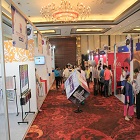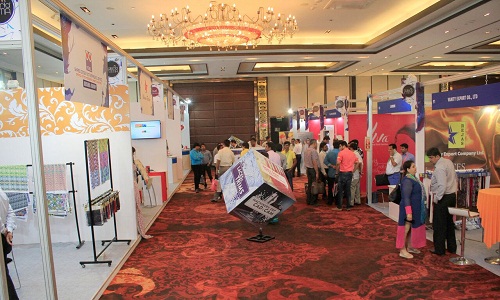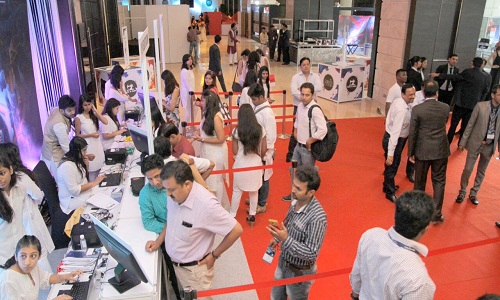FW
"The fifth edition of Galleria Intim, a trade fair that seeks to renovate the intimate apparel segment in India, is expected to attract more than 2,000 visitors from India and abroad. The annual trade fare is slated to take place in New Delhi from August 5-6. Over 1,000 brands from India alone are expected to visit the event. Committed to leverage the opportunities created by ‘Make in India’ initiative, the event is set to project India as a manufacturing hub for domestic, as well as global intimate wear market. Intimate Apparel Association of India (IAAI) will be exploring the possibilities of the future."

The fifth edition of Galleria Intim, a trade fair that seeks to renovate the intimate apparel segment in India, is expected to attract more than 2,000 visitors from India and abroad. The annual trade fare is slated to take place in New Delhi from August 5-6. Over 1,000 brands from India alone are expected to visit the event. Committed to leverage the opportunities created by ‘Make in India’ initiative, the event is set to project India as a manufacturing hub for domestic, as well as global intimate wear market. Intimate Apparel Association of India (IAAI) will be exploring the possibilities of the future.
Experts feel, the future growth indicators of Indian intimate wear industry include a robust domestic market that has been growing at an annual rate of 15 per cent to 20 per cent. According to IAAI, this gives Indian brands a good ground to build upon.
Advantage India

As per IAAI reports China, the long-standing indisputable leader of global textile export market is demonstrating a slowdown in domestic economy resulting in lower international competitiveness. Meanwhile, top international brands like Victoria’s Secret, Fruit of the Loom, Aerie, Warnaco Group, La Senza, Hanesbrands, and others that dominate the global market have been getting their products made in countries like China following a steep rise in manufacturing costs in Europe and the US. China for years has remained the largest supplier of intimate wear. However, the country’s companies were recently forced to increase their labour costs, making their products less competitive in the international market.
Incidentally, Chinese labour costs are nearly four times higher than in India. Continuous rise is disposable income of the Indian middle class means that the domestic market for intimate wear will remain robust in the years to come, according to IAAI. This makes India a potential hub for global manufacturing.
Opportunities Ahead

In the backdrop of ‘Make in India’ campaign, the fifth edition of Galleria Intima will bring together major domestic and international players of the global intimate wear industry. Brand owners, manufacturers of intimate wear, designers, export houses, large format retailers, online retailers and buying houses from all over the world will stand under one roof.
Galleria Intima offers a platform for domestic and international buyers to see the latest innovations, most spectacular designs and products that are the result of thorough research and development process. So far, the show has received exhibitor participation from countries such as Italy, Turkey, China, Germany, Sri Lanka and Thailand, apart from India.
IAAI is committed to shore up India’s share in the global intimate wear export market from 4 per cent to 10 per cent by 2025. IAAI is guided by the vision to acquire for India a leader’s position in the global intimate wear market by persistently working towards the promotion and development of the industry.
The textiles industry, which has been struggling due to increasing competition from neighbouring countries like Bangladesh, Indonesia and Vietnam, coupled with rising imports into India and other domestic issues like GST, is now feeling the pinch of a strengthening rupee. The industry is ruling out the possibility of achieving its total export target of $45 billion in the current fiscal.
Sanjay Kumar Jain, Chairman, Confederation of Indian Textile Industry (CITI), says exports were down 40 per cent in October, followed by 13 per cent in November. In December too, the exports came down sharply. If the trend continues, the projected textile export target of $45 billion in the current fiscal will be clearly unachievable.
Given the variation in both the rupee and cotton prices, exporters are unable to take orders or fix any price point to do jobs. Textile exports from India include ready-made and knitwear garments, cotton yarn, fabrics, made-ups, handicraft items, man-made yarns, fabrics and jute products, among other items.
TEA officials say, total ready-made garment exports from India has declined to Rs 78,966 crore in the April-December 2017 period as compared to Rs 83,430 crore in the same period of last fiscal. Of the total exports, exports in dollar terms are estimated at 55 per cent, in Euro at 30 per cent and in Pound Sterling at 12 per cent.
Out of total exports from Tirupur, nearly 10 per cent of big exporters garner 50 per cent of total export value while 90 per cent of small scale exporters account for the remaining 50 per cent, and the impact of rupee appreciation will be more severe on the SMEs.
Uttarakhand is ready to set up a series of textile parks. A host of incentives will be available to attract new investments. Three textile parks will be set up. Land will be available under the prevailing price. The company setting up a new unit will be given a 50 per cent rebate on the land price. The allottee has to pay 20 per cent of the land premium at the time of allotment and the balance payment is to be deposited within seven years in equal installment on the prevailing rate of interest. The scheme will remain in force till March 31, 2021.
A state capital subsidy will be offered. For medium and small enterprises, the capital subsidy will be 15 per cent to a maximum limit of Rs 50 lakhs and for heavy industry it’s 15 per cent to a maximum limit of Rs 30 lakhs.
An interest subsidy of seven per cent will also be offered. Cent per cent VAT concession will be given on purchase of raw materials and on sale of finished goods for seven years from the start of the production. A rebate of Rs 1 per unit is also available on power bills. There will be 100 per cent stamp duty rebate on the purchase of land.
Intexpo Bangladesh 2016 is being held on May 30 and 31. This is an Indian textile exhibition that aims at tapping the growing business potential especially that of manmade fibers. The expo aims to provide unique opportunities to the textile and garment business fraternity of Bangladesh to see the quality and range of Indian fabrics and yarns. It also enables them to establish personal contacts for mutually beneficial business tie-ups, including the possibility of having long term venture alliances with their Indian counterparts.
A total of 30 leading Indian manufacturing and exporting companies are displaying their latest range of textile items such as suitings, shirtings, dress materials, embroidered fabrics, high fashion fabrics, furnishings, home textiles, made-ups like scarves, stoles, shawls, laces, synthetic and blended yarns, fibers and garments in the expo. Labor cost, market access to the EU and the US are among the advantages of Bangladesh which Indian exporters can leverage.
The expo enables Indian exporters to meet prospective buyers or agents to generate business enquiries, help exporters to this market to further expand their contacts and give opportunities to new exporters to establish trade contacts with prospective customers or buyers.
India exported manmade textile fibers worth$134.05 million in the 2010-11 fiscal.
Exports of 100 per cent man-made fiber yarns from India were up 13.8 per cent in April 2016 as compared to the same month last year. Polyester yarn exports were up 25.1 per cent in value while viscose yarn exports value were up 29.7 per cent during the month. Acrylic yarn exports saw a drastic plunge of 36.2 per cent in April.
Polyester spun yarns were exported to 42 countries from India in April with total volumes at of 3.43 million kg, of which 16.2 per cent was shipped by Turkey alone. Nine new destinations were found for polyester yarn this April, of which Syria, Mexico, Togo and Tunisia were the major ones.
Nine new destinations were found for polyester yarn this April, of which Syria, Mexico, Togo and Tunisia were the major ones. Egypt, Morocco and Philippines were the fastest growing markets for polyester yarns while nine countries did not import any polyester yarns during the month.
China, Sri Lanka, Bangladesh and USA were the fastest growing markets for viscose yarns while Egypt, Bangladesh, Morocco, Brazil and Canada were the new major markets. United Kingdom, South Africa and Peru were the major ones among the six countries that did not import any viscose yarns during the month.
Nandan Denim has reported a net profit of Rs 63.32 crores for the FY 2015-16 as against Rs 51.43 crores in FY 2014-15, a rise of 23 per cent. Net sales for FY 2015-16 at Rs 1,156.72 crores were higher by five percent. over the previous fiscal’s net sales. The company reported a healthy EBITDA and PAT margin in FY 16 at 16.9 per cent and 5.5 per cent respectively. Basic EPS for FY 16 stood at Rs 13.90. Meanwhile, Nandan Denim is poised to be Asia’s largest denim fabric manufacturer.
For the quarter ended March 2016, the company reported a net profit of Rs 16.57 crores against a net profit of Rs 15.37 crores in the corresponding period last year, a growth of eight per cent. Net sales in the quarter at Rs 294.31 crores were higher by six per cent compared to Rs 278.31 crores in the same period in the previous fiscal. For the quarter, EBITDA margin stood at 16.5 per cent and PAT margin at 5.6 per cent.
The company had made a preferential placement of 25,00,000 convertible warrants at a conversion price of Rs 200 each. The entire money of Rs 50 crores has been received and equivalent numbers of equity shares have been allotted to the investor.
Currently Nandan Denim has an installed capacity of around 99 million meters of denim and expects to take it to around 110 million meters. Looking to the average utilisation of around 80 to 85 per cent the company expects to be able to add another eight per cent to it. So a five per cent volume growth looks very much on the cards in the financial year 2017. Going forward Nandan Denim is going to work seriously on exports front and is expecting a decent hike in export volumes and topline as well. The company is working to enhance the value addition in the manufacturing process. So it expects a decent hike coming through the price part as well.
According to a survey by business i provider Ethical Corporation's 2,000 plus business executives has found that only half of them believe that sustainability is driving revenue. The report ‘State of Responsible Business 2016’ by the UK-based Ethical Corporation found 49 per cent corporate respondents either ‘don't know’ or ‘don't believe’ that sustainability is driving revenue for their business.
Apparel, FMCG and manufacturing firms are amongst the most likely to acknowledge the benefit of sustainability, and those from financial and professional services sectors were less likely to agree, the report says. The latest report, builds upon the inaugural report published last year, 52 per cent apparel, FMCG and manufacturing respondents said that they pay for external assistance with their sustainability strategy. Seventy one per cent of corporate/brand respondents said that their CEO is convinced of the value of sustainability.
Ethical Corporation's report found that there's been a 9 per cent increase globally in those feeling that sustainability is integrated tightly enough into broader business strategies.
A campaigner for higher wages in Asia has urged global clothing brands to take responsibility for the millions of workers in the region who are poorly paid by suppliers and ignored by governments. Incidentally, Asia accounts for more than 60 per cent of the world's garment production, with the industry employing more than 15 million people directly, most of them women.
According to Anannya Bhattacharjee, Coordinator with the Asia Floor Wage Alliance (AFWA), a supply chain lobby group, workers deserve a living wage because the minimum wage set by most Asian countries is inadequate to keep them out of poverty. Meanwhile, higher wages in China, the world's largest clothing exporter, are driving brands worldwide to seek cheaper alternatives in countries such as Bangladesh, India, Pakistan and Sri Lanka. Suppliers in these countries are under enormous pressure to reduce costs and produce garments as quickly as possible.
Wages in the garment industry are ‘structurally failing’ to meet workers' basic needs, leading to excessive overtime, ill health and workers being forced to live apart from their families, according to the Clean Clothes Campaign, which is a member of AFWA.
At the International Labor Conference (ILC), Clean Clothes Campaign will call upon the representatives of governments, employers’ and workers’ organizations from 187 member states to establish institutional and enforcement frameworks that enable effective remedy after disasters and prevention of disasters in global supply chains. For the first time in the long history of the ILC, global supply chain issues are a main focus of the conference and follow the work of the Committee on Decent Work in Global Supply Chains with heightened interest.
Clean Clothes Campaign is represented at the conference by a delegation of trade unionists and labor activists from Europe and Asia. The delegation will use its presence at the conference to emphasize the need for an institutional framework for remedy and prevention that can be scaled up to an enforceable solution. On the opening day, Clean Clothes Campaign will address these concerns in a short plenary speech.
At the ILC, the Clean Clothes Campaign will reiterate that it is demonstrably not sufficient to just bring supply chain actors together in a dialogue and rely on their collective ability to take action. The campaign knocks on the door of the International Labor Organization to become involved in overcoming the weaknesses of non-binding initiatives and to enhance collaboration and transparency among the industry partners.
The Bangladeshi apparel makers expected that the upcoming FY 2016-17 Budget would be investment-friendly and people-oriented that would help create employment for all levels of workforce, both skilled and unskilled. According to them about 2 million jobseekers are coming to the market every year. Out of that, only six lakh are getting jobs, though CPD research claimed seven lakh are being provided with jobs each year.
The country’s RMG industry has now got a new journey following the remediation of the factory buildings as per the recommendations of the Accord on Fire and Building Safety and the Alliance for Bangladesh Workers Safety – the two platforms of North American and European retailers and brands. The government also conducted the same task in bringing improvement at the work places.
According to RMG leaders, the remediation process is going on at factories, and they need huge investment to be compliant. Each factory requires up to Tk 1 crore to Tk 5 crore as additional investment for remediation. At the same time, the apparel makers are investing in setting up green factories, and so far 29 have been certified as green factories, while 130 are registered with USGBC for establishing green factories, observed Md Siddiqur Rahman, President of the Bangladesh Garment Manufacturers and Exporters Association (BGMEA).
The BGMEA president said that a total of 618 RMG units have been closed, while another 319 are at the edge of closure for losing competitiveness and other challenges, talking on present condition of the apparel sector.












